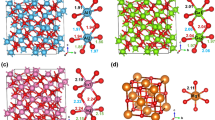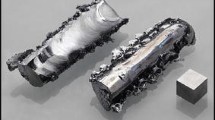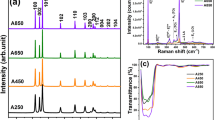Abstract
Cyanogen halides are a group of highly toxic and colorless compounds. Their presence in the environment and direct contact with these compounds can be dangerous. So finding a reliable and accurate sensor for these compounds can be very beneficial. In this study, the adsorption of cyanogen halides (XCN, X = F, Cl, and Br) on 2PANI was investigated, using UB3LYP/6-31G*(d) as a DFT method. The binding energies between 2PANI and XCN were calculated. Also, Mulliken charge transfer (QMulliken), molecular electrostatic potential (MEP) and the global indices of activities were calculated and orbital analyses were performed. Based on our results, it can be found that at proper configuration the FCN, ClCN, and BrCN molecules can be adsorbed on 2PANI with adsorption energies (Eads) of –9.975, –11.025, and –26.510 kJ/mol, respectively. As a result, 2PANI can be used as a useful, portable, and cheap sensor for cyanogen halides.




Similar content being viewed by others
REFERENCES
C. Peng, J. Jin, and G. Z. Chen, Elect. Acta 53, 525 (2007).
M. Ates, Mater. Sci. Eng. C 33, 1853 (2013).
M. Ates, Prog. Org. Coat. 71, 1 (2011).
H. Bai and G. Shi, MDPI 7, 267 (2007).
J. Janata and M. Josowicz, Nature (London, U.K.) 2, 19 (2003).
H. Ullah, A. A. Shah, S. Bilal, and K. Ayub, J. Phys. Chem. C 117, 23701 (2013).
A. S. Rad, M. Esfahanian, E. Ganjian, and H. A. Tayebi, Zeitschr. Phys. Chem. 230, 1487 (2016).
I. Fratoddi, I. Venditti, C. Cametti, and M. V. Russo, Sens. Actuators, B 220, 534 (2015).
P. Jiménez, W. K. Maser, P. Castell, M. T. Martinez, and A. M. Benito, Macromol. Rapid Commun. 30, 418 (2009).
Y. Xia, A. G. MacDiarmid, and A. J. Epstein, Macromolecules 27, 7212 (1994).
T. Thanpitcha, A. Sirivat, A. M. Jamieson, and R. Rujiravanit, Carbohydr. Polym. 64, 560 (2006).
A. S. Rad, S. G. Ateni, H. Tayebi, P. Valipour, and V. P. Foukolaei, J. Sulf. Chem. 37, 622 (2016).
D. W. Kononen, Bull. Environ. Con. Toxicol. 41, 371 (1988).
X. Yang and C. Shang, Water Res. 39, 1709 (2005).
F. S. Fawcett and R. D. Lipscomb, J. Am. Chem. Soc. 86, 2576 (1964).
J. M. Roberts and Y. Liu, Atmos. Chem. Phys. 19, 4419 (2019).
P. Zucca and E. Sanjust, Molecules 19, 14139 (2014).
E. Vessally, F. Behmagham, B. Massuomi, A. Hosseinian, and K. Nejati, J. Mol. Model. 23, 138 (2017).
E. B. Kadossov, P. Rajasekar, and N. F. Materer, J. Phys. Chem. B 108, 303 (2004).
M. J. Frisch, G. W. Trucks, H. B. Schlegel, G. E. Scuseria, M. A. Robb, J. R. Cheeseman, G. Scalmani, V. Barone, G. A. Petersson, H. Nakatsuji, X. Li, M. Caricato, A. Marenich, J. Bloino, B. G. Janesko, et al., Gaussian 09, Revision A.02 (Gaussian, Inc., Wallingford CT, 2016).
T. Koopmans, Physica (Amsterdam, Neth.) 1, 104 (1934).
P. Politzer, J. S. Murray, and Z. Peralta-Inga, Int. J. Quantum Chem. 85, 676 (2001).
P. Thul, V. P. Gupta, V. J. Ram, and P. Tandon, Spectrochim. Acta 75, 251 (2010).
M. Arjmandi, M. Peyravi, M. Pourafshari Chenar, M. Jahanshahi, and A. Arjmandi, J. Water Environ. Nanotechnol. 3, 70 (2018).
K. Fukui, T. Yonezawa, and H. Shingu, Chem. Phys. 20, 722 (1952).
M. Peyravi, M. Arjmandi, R. Khakpour, and M. Jahanshahi, Surf. Interfac. 16, 174 (2019).
B. J. Chem. Educ. 76, 320 (1999).
M. Kamran, H. Ullah, A. A. Shah, S. Bilal, A. A. Tahir, and K. Ayub, Polymer 72, 30 (2015).
M. Arjmandi, M. Pourafshari Chenar, M. Peyravi, M. Jahanshahi, A. Arjmandi, and A. Shokuhi Rad, IJE Trans. C: Asp. 31, 1473 (2018).
IUPAC, Compendium of Chemical Terminology, 2nd ed. (Gold Book, 1997).
Funding
The authors acknowledge the funding support of Babol Noshirvani University of Technology through grant program no. BNUT/389026/97.
Author information
Authors and Affiliations
Corresponding authors
Rights and permissions
About this article
Cite this article
Mehrzad Arjmandi, Arjmandi, A., Peyravi, M. et al. First-Principles Study of Adsorption of XCN (X = F, Cl, and Br) on Surfaces of Polyaniline. Russ. J. Phys. Chem. 94, 2148–2154 (2020). https://doi.org/10.1134/S0036024420100027
Received:
Revised:
Accepted:
Published:
Issue Date:
DOI: https://doi.org/10.1134/S0036024420100027




